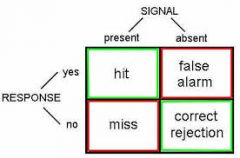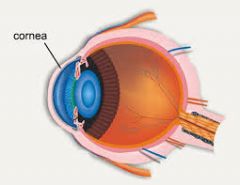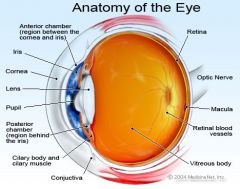![]()
![]()
![]()
Use LEFT and RIGHT arrow keys to navigate between flashcards;
Use UP and DOWN arrow keys to flip the card;
H to show hint;
A reads text to speech;
56 Cards in this Set
- Front
- Back
|
sensation |
conversion or transduction of physical, electromagnetic, auditory, and other info form the internal and external environment into electrical signals in the nervous system |
|
|
perception |
processing of sensory info to make sense of the significance. |
|
|
sensory receptors |
nerves that respond to stimuli and trigger electrical signals |
|
|
sensory ganglia |
collections of cell bodies outside the CNS |
|
|
common sensory receptors |
1. photoreceptors 2. hair cells 3. nociceptors 4. thrmoreceptors 5. osmoreceptors 6. olfactory 7. taste |
|
|
threshold |
minimum stimulus that causes a change in signal transduction |
|
|
absolute threshold |
min. of stimulus energy needed to activate a sensory system |
|
|
threshold of conscious perception |
the minimum stimulus energy that will create a signal large enough in size and long enough in duration to be brought into awareness |
|
|
difference threshold |
min. diff. in mag. between 2 stimuli before once can perceive the difference. |
|
|
weber's law |
that DF or JND for a stimulus is proportional to the magnitude of the stimulus and that this proportion is constant over most of the range of possible stimuli |
|
|
signal detection theory |
refers to the effects of nonsensory factors, such as experiences, motives, and expectations, on perception of stimuli |
|
|
response bias (through signal detection experiment) |

in an experiment a stimulus may or may not be given and the subject is asked to state whether or not the stimulus was given. There are four possible outcomes: hits, misses, false alarms, or correct negatives. |
|
|
adaption |
decrease in response to stimulus over time |
|
|
cornea |

gathers and filters light |
|
|
iris |

colored part, divides the eye into the anterior and posterior chamber. It has two muscles: the dilator and constrictor pupillae which open and close the pupil. |
|
|
lens |
refracts incoming light to focus it on the retina and is held in place by suspensory ligaments connected to the cilliary muscle |
|
|
aqueous humor |
produced by the ciliary body and drains through the canal of schlemm. |
|
|
rods |
detect light and dark |
|
|
cones |
come in three forms (Short, medium, long) to detect colors |
|
|
where are cones located |
in the retina in the macula which corresponds to the central visual fields. The center of the macula is the fovea which contains only cones. |
|
|
signal transduction in the eye |
rods and cones synapse on bipolar cells, which synapse on ganglion cells. Edge sharpening is performed by horizontal and amacrine cells. |
|
|
visual pathway |
eye, optic nerves, optic chiasm, optic tracts, lateral geniculate nucleus of the thalamus, visual radiations to get to the visual cortex. |
|
|
optic chiasm |
contains fibers crossing from the nasal side of the retina of both eye |
|
|
visual radiations |
run through the temporal and parietal lobes |
|
|
visual cortex |
occipital lobe |
|
|
how is vision processed |
through parallel processing: the ability to analyze and combine info regarding color, shape, and motion |
|
|
how is shape detected? |
parvocellular cells |
|
|
how is motion detected? |
magnocellular cells |
|
|
ear division (3) |
1. outer 2. middle 3. inner |
|
|
outer ear (3 parts) |
1. pinna 2. external auditory canal 3. tympanic membrane |
|
|
middle ear (3 parts) |
1. ossicles: malleus, incus, stapes 2. oval window 3. eustachian tube |
|
|
inner ear (components) |
1. bony labyrinth 2. membranous labyrinth 3. perilymph 4. endolymph 5. cochlea 6. utricle and saccule semicircular canals |
|
|
perilymph |
fills the bony labyrinth |
|
|
endolymph |
fills the membranous labyrinth |
|
|
cochlea |
detects sound |
|
|
utricle and saccule |
detect linear motion |
|
|
semicircular canals |
detects rotational acceleration |
|
|
auditory pathway |
cochlea, travels thought the vestibulocochlear nerve and medial geniculate nucleus of the thalamus to the auditory cortex in the temporal lobe |
|
|
superior olive |
localizes sound |
|
|
inferrior colliculus |
involved in startle reflex |
|
|
olfactory pathway |
olfactory nerves, olfactory bulb, OF tract, limbic system. |
|
|
somatosensation (4 modalities) |
pressure, vibration, pain, temp. |
|
|
2 point threshold |
min distance between two points of stimulation on skin the the points will be felt as 2 distinct stimuli |
|
|
physiological zero |
normal temp of the skin to which objects are compared to determine if they are hot or cold. |
|
|
noicerecptors |
detect pain |
|
|
gate theory of pain |
pain sensation if reduced when other ss signals are present |
|
|
kinesthetic sense |
the ability to tell where one's body is in 3D space |
|
|
bottom-up processing |
recognition of objects by parallel processing. Slower but less prone to mistakes |
|
|
top-down processing |
recognition of objects by memories and expectations, with little attention to detail. faster but prone to mistakes |
|
|
Gestalt principles |
ways that the brain can infer missing parts of picture when a pic is incomplete |
|
|
GP: law of proximity |
elements close to one another tend to be perceived as a unit |
|
|
GP: law of similarity |
objects that are sim appear to be grouped together |
|
|
GP: law of good con. |
elements appear to follow the same pathway tend to be grouped together |
|
|
GP: subjective contours |
perception of non-existent edges in figures |
|
|
GP: law of closure |
when a space is enclosed by a group of lines, it is perceived as a complete or closed line |
|
|
law of pragnanz |
perceptual organization will always be as regular, simple, and symmetric as possible. |

